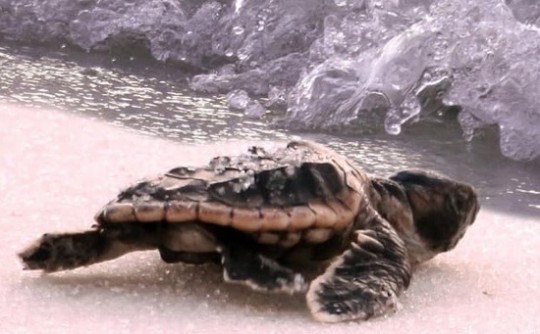First Sea Turtles Of The Year Hatch On Pensacola Beach
August 10, 2020
Pensacola Beach saw its first sea turtle hatch of the season Sunday night. Approximately 129 loggerhead hatchlings emerged on the county-patrolled portion of Pensacola Beach and made their way to the Gulf of Mexico.
Sea turtles nest May through October along the Gulf Coast and nests incubate for around 60 days. Once the sun sets, hatchlings emerge all at once and make their way to the Gulf of Mexico. They will spend their first few days in a swimming frenzy to escape the many predators found in nearshore waters. Safer in the open ocean, they will use floating mats of algae to hide and feed until they are big enough to return to nearshore areas.
Sea turtle hatchlings face many threats long before they reach the water. Bright lights from homes, flashlights and cars can lead hatchlings away from the Gulf and into danger. Nearly 60% of hatchlings will be disorientated before reaching the Gulf of Mexico.
Forgotten furniture, toys, sandcastles, and holes can trap hatchlings, causing injury, starvation, and dehydration. Food and other waste left on the beach attracts gulls, crows, stray dogs, and coyotes who also prey on hatchling turtles.
Escambia County recommends the following to protect sea turtles:
- Lights Out! Both hatchlings and nesting turtles need dark beaches to find the Gulf of Mexico. Leave the flashlights and cell phones at home or use a red flashlight when on the beach at night. Turn off beach-facing lights and close windows and curtains to keep our beaches dark.
- Leave No Trace! Remove all furniture and toys from the beach when you’re done for the day, including hammocks, tents, canopies, chairs, toys and sports equipment.
- Stow It, Don’t Throw it! Trash and food waste can entangle turtles and other wildlife and attract unwanted predators. Always dispose of trash in the proper receptacle and refrain from feeding wildlife.
If you see a nest hatching or encounter hatchlings turtles on the beach, stay a respectful distance away and call Escambia County Marine Resources at 850- 426-1257.
Comments
5 Responses to “First Sea Turtles Of The Year Hatch On Pensacola Beach”




REGARDING:
“I think I read somewhere that only a tiny fraction of turtles survive the first days after they hatch, .”
True.
“On the beach, hatchlings must escape natural predators like birds, crabs, raccoons, and foxes to make it to the sea. Once in the water, hatchlings are consumed by seabirds and fish. Few survive to adulthood, with estimates ranging from one in 1,000 to one in 10,000.” https://oceanservice.noaa.gov/news/june15/sea-turtles.html
“swoop up a batch and raise them until they got older and then release them into the Gulf”
Always tempting.
I knew a fellow who did it by accident. He gathered the eggs and was eating them. (Yes, illegal but before I met him and he wouldn’t have asked anyone’s permission.) He took too long and a bunch hatched. He waited until dark and released them in the Atlantic. Probably none would have made it that far if not for him.
I have read of people gathering alligator eggs, hatching them, using them for meat and hides. They release into the wild the percentage which would have survived to that age. All done through proper channels with reasonable people.
Oh the adventures that await that little fellow.
I AGREE WITH BEWILDERED. SAVE THE TURTLES, DO NOT LET THEM BE FOOD FOR OTHER THINGS.
I am wondering why Gulfarium experts or the like could not swoop up a batch and raise them until they got older and then release them into the Gulf. I think I read somewhere that only a tiny fraction of turtles survive the first days after they hatch, .
Glad to see the turtles have made a comeback. My wife and I saw 5 large ones 2 weeks ago in Big Lagoon. They were only a few feet from the boat with their back fins sticking up in the air going back and forth.